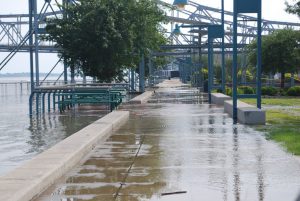Three innovative stormwater projects in the Southeast U.S. have received the 2017 U.S. Environmental Protection Agency (EPA) Region 4 Rain Catcher awards. The honorees earned recognition during a May 15 ceremony at the International Erosion Control Association (Denver) Municipal Wet Weather Stormwater Conference in Charleston, S.C.
“The EPA Region 4 Rain Catcher Award recognizes excellence in the implementation of stormwater green infrastructure practices,” an EPA representative explained in a press release. “EPA and its partner organizations have promoted the use of green infrastructure for many years as part of a comprehensive approach to achieving healthier waters.”
Community category: North Carolina Collaborative Project Team

The North Carolina Collaborative Project Team constructed a rain garden as one of eight interventions that improve the stormwater management capabilities of the state’s southeastern shore. The team’s work earned a 2017 Rain Catcher Award in the Community category. U.S. Environmental Protection Agency
In the Community category, the award went to the North Carolina Collaborative Project Team, a partnership responsible for bringing eight stormwater-mitigating features to the municipalities surrounding Masonboro Sound and Bradley and Hewletts Creeks on North Carolina’s southeast cost.
The team, led by the North Carolina National Estuarine Research Reserve (Beaufort), the North Carolina Coastal Federation (Newport), and the University of North Carolina (UNC; Wilmington), focused their interventions on the Town of Wrightsville Beach and the City of Wilmington.
Between 2013 and 2017, the team
- re-graded a landscaped area in front of a restaurant to improve infiltration;
- retrofitted curbs and installed reverse storm inlets to divert roadway runoff to grassed areas;
- planted a new rain garden;
- re-examined stormwater flows to capitalize on the new rain garden;
- added earthen check dams to roadside swales to slow down stormwater;
- installed permeable concrete in otherwise impermeable parking lots;
- laid about 45 m (150 ft) of perforated pipe along an outfall pipe to improve infiltration; and
- worked with local homeowners to install permeable concrete on six private driveways.
The National Oceanic and Atmospheric Administration-funded project team commissioned UNC researchers to monitor installation sites before and after its intervention. All told, a majority of the management sites displayed 50% to 90% reductions in stormwater volumes that eventually enter impaired waterways.
Municipal category: Charlotte-Mecklenburg Storm Water Services and Town of Morrisville
Elsewhere in North Carolina, Charlotte-Mecklenburg Storm Water Services (Charlotte; CMSWS) and the Town of Morrisville shared the Rain Catcher award in the Municipal category.
An initiative 15 years in the making, the Charlotte-Mecklenburg Schools South Park Watershed Enhancement Project brought five stormwater control measures to a 14.5- ha (36-ac) public school campus, greatly reducing the site’s runoff volume to the Little Sugar Creek Watershed. The effort, managed by CMSWS, involved close cooperation between the agency and school faculty to identify which campus locations would provide the most benefit to the watershed while also offering educational opportunities to students.
After a lengthy planning and fundraising process, CMSWS engineers installed two bio-retention areas; an infiltration trench; and a wet detention pond with a sand filter. All interventions were built in areas with permanent easements, which will ensure long-term maintenance of each site.
In Morrisville, town architects created a new neighborhood park with stormwater management in mind, aiming to curb runoff from flowing into a nearby stream which feeds a drinking water reservoir for Morrisville and surrounding towns.
The 2-ha (5-ac) park, which officially opened last October, features rentable picnic areas, a walking loop lined with infiltration beds and vegetated swales, and a playground with a permeable surface. It also contains large subsurface drainage fields, a 11,356-L (3000-gal) rainwater-harvesting cistern, and educational signage to teach visitors about the park’s innovative design.
Commercial category: James A. Reeder Riverfront Development Corporation

The unpredictable fluctuation of the Mississippi River — usually between 9 and 12 m (30 and 40 ft) each year — represents a challenge for riverfront developers. Building too close to the shoreline presents flood risks, and building too far away defeats the purpose of riverfront property. For its Beale Street Landing project, the James A. Reeder Riverfront Development Corporation used innovative design techniques to work with the Mississippi River while also employing state-of-the-art stormwater management techniques. U.S. Army Corps of Engineers
The James A. Reeder Riverfront Development Corporation (Memphis, Tenn.) earned the Rain Catcher award in the Commercial category for its construction of the Beale Street Landing waterfront park along the banks of the Mississippi River, completed in 2014.
Comprised of 2.4 ha (6 ac), Beale Street Landing contains a public park with several terraces and two protruding islands with articulating concrete blocks as their foundation. The concrete islands stabilize the eroding river banks along the lower areas of the park. Each island is equipped with 43 small-area inlets and three trench drains to collect stormwater runoff from contaminating the Mississippi River. They also enable access to the riverfront even when the river rises higher than the park’s lowest terraces.
Amid shops and restaurants on the riverfront is a new terminal building with a 0.52-ha (1.3-ac) arched-grass roof. The grass on the roof can retain nearly 80% of rainfall, with the remaining runoff filtered through vegetation and captured by drainage inlets and trench drains. The $42 million project also features a fully accessible riverboat loading and unloading station via a 122-m (400-ft) floating dock that freely rises or lowers with the Mississippi River.
The developments offer unprecedented access to the many riverboats that dock at the site while generating income for Memphis and a cleaner Mississippi River.





